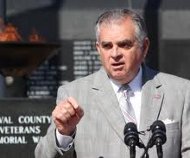Link to article here.
I-TEAM: Congressman Canseco says he was assaulted during TSA pat-down
by Brian New / KENS 5
Posted on April 24, 2012 at 5:30 PM
Updated
today at 12:18 PM
U.S. Rep. Francisco Canseco said he was assaulted by a TSA agent at the San Antonio International Airport.
The Texas Congressman said the security agent went too far during a pat-down earlier this month.
"The agent was very aggressive in his pat-down, and he was patting me
down where no one is supposed to go,” said Canseco. “It got very
uncomfortable so I moved his hand away. That stopped everything and
brought in supervisors and everyone else."
Canseco told the KENS 5 I-Team the agent said he too was assaulted when Canseco pushed his hand away.
According to TSA, neither man was cited.
A week later when going through the San Antonio International Airport, Canseco was once again selected for a pat-down.
"I did not see it as a coincidence,” he said. “I asked them why are
you going to pat me down again, so we discussed it further and after
discussing it further, they patted me down."
However, before the discussion was over, San Antonio Police Department officers were called to the security check point area.
Again, no one was cited.
TSA issued the I-Team the following statement about the incident:
"TSA incorporates random and unpredictable security measures
throughout the airport. Once a passenger enters the screening process,
they must complete it prior to continuing to a flight or secure area."
Canseco said his experience illustrated changes in the airport security are needed.
"It is very important that Americans feel safe and secure as they
travel in our nation’s airways - safe and secure from acts of terrorism
and all that. But, I also think that TSA sometimes gets too aggressive,
and it's not just about me. It's about every American that goes through
those TSA scanners."
The I-Team requested video from TSA of both incidents. A TSA spokesperson said our request is being reviewed.
-------------------------------------------------------------------------------------------------
UPDATE 4/25
TSA issued the following statement:
TSA has been contacted by the Congressman's office and will
respond to them directly. Once a passenger enters the screening process,
they must complete it prior to continuing to a flight or secure area.

 Like TURF
Like TURF Follow TURF
Follow TURF US
Trans- portation Secretary Ray LaHood is distancing himself from reports
that he called for a federal law banning all cell phone use behind the
wheel. The former Illinois congressman was in San Antonio, Texas
speaking at a distracted driving summit. According to a widely cited
Reuters report, "LaHood called on Thursday for a federal law to ban
talking on a cell phone or texting while driving any type of vehicle on
any road in the country." Not so, said a spokesman for the department.
US
Trans- portation Secretary Ray LaHood is distancing himself from reports
that he called for a federal law banning all cell phone use behind the
wheel. The former Illinois congressman was in San Antonio, Texas
speaking at a distracted driving summit. According to a widely cited
Reuters report, "LaHood called on Thursday for a federal law to ban
talking on a cell phone or texting while driving any type of vehicle on
any road in the country." Not so, said a spokesman for the department.